
𝟭𝟵𝟴𝟬:Wojciech “Al” Krotoski et al publish a report in the British Medical Journal describing a dormant liver stage of #Plasmodium cynomolgi in Rhesus macaques. These dormant liver stages, called "hypnozoites" are postulated to be the cause of relapses of this #malaria species 

- Image references: ncbi.nlm.nih.gov/pmc/articles/P…; ajtmh.org/view/journals/…
- References: https://t.co/QDyaZSACDa; https://t.co/zzZPG6Ze3M; link.springer.com/article/10.100…
- References: https://t.co/QDyaZSACDa; https://t.co/zzZPG6Ze3M; link.springer.com/article/10.100…
𝟭𝟵𝟴𝟭: In 1981, Dr William C. Campbell of the Merck Institute for Therapeutic Research in the US, published "An Introduction to the Avermectins" which described a new series of compounds with potent antiparasitic properties against nematode & arthropod #parasites. 

- Image references: science.org/doi/10.1126/sc…; nobelprize.org/prizes/medicin…
- References: tandfonline.com/doi/abs/10.108…; https://t.co/VktKLF38ll
- References: tandfonline.com/doi/abs/10.108…; https://t.co/VktKLF38ll
𝟭𝟵𝟴𝟮: In 1982, Drs Orihel & Eberhard at Tulane University in the USA published a paper redesignating 3 filarial nematode infections of humans under the genus name "Mansonella": M. ozzardi, M. perstans, & M. streptocerca. Mansonellosis remains a neglected tropical disease. 

- Image references: ajtmh.org/view/journals/…; sciencedirect.com/science/articl…
- References: ncbi.nlm.nih.gov/pmc/articles/P…; https://t.co/l1EsSekJDq; https://t.co/Wokr8J2VlA
- References: ncbi.nlm.nih.gov/pmc/articles/P…; https://t.co/l1EsSekJDq; https://t.co/Wokr8J2VlA
𝟭𝟵𝟴𝟯: #Parasitology does not occur within a vacuum & in 1983, a new retrovirus was discovered in patients with "pre-AIDS". For years to come, the AIDS epidemic would increase the number of immunocompromised patients appearing with opportunistic parasitic infections. 
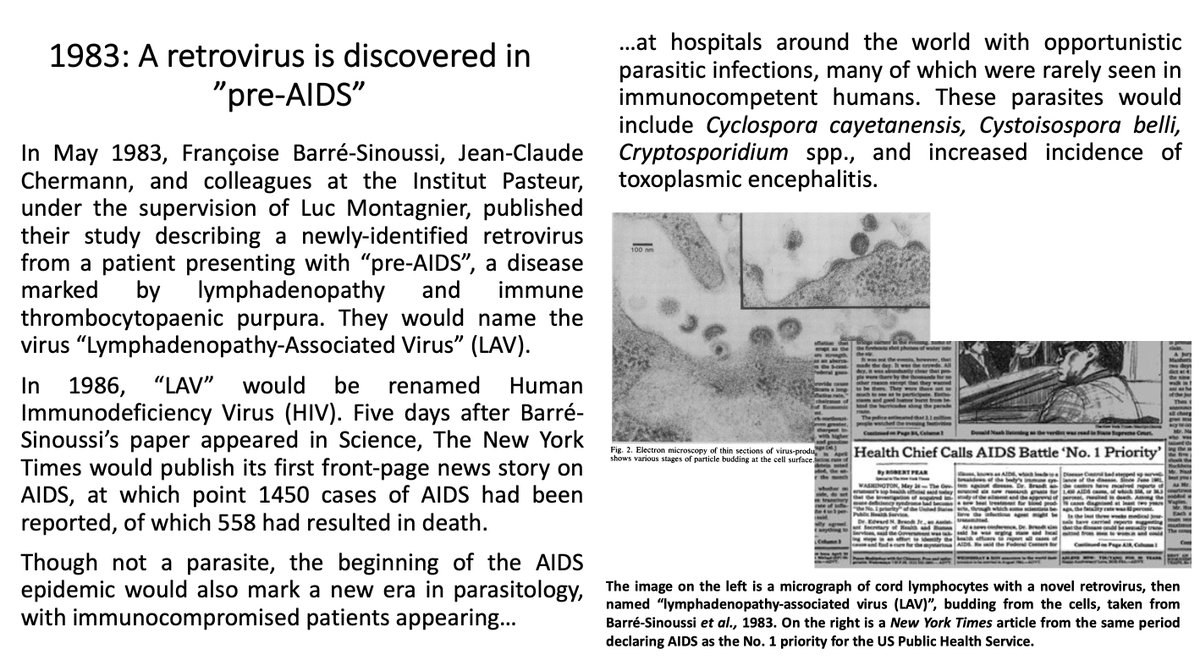
- Image references: science.org/doi/10.1126/sc…; nytimes.com/1983/05/25/us/…
- References: https://t.co/PSpHet15LJ; https://t.co/Mc0mS59bC4; nejm.org/doi/full/10.10…; iris.paho.org/bitstream/hand…; ncbi.nlm.nih.gov/pmc/articles/P…; pubmed.ncbi.nlm.nih.gov/19700803/; thelancet.com/journals/lanhi…
- References: https://t.co/PSpHet15LJ; https://t.co/Mc0mS59bC4; nejm.org/doi/full/10.10…; iris.paho.org/bitstream/hand…; ncbi.nlm.nih.gov/pmc/articles/P…; pubmed.ncbi.nlm.nih.gov/19700803/; thelancet.com/journals/lanhi…
𝟭𝟵𝟴𝟰: After centuries, possibly millenia, of being used for blood-letting, the medicinal leech, Hirudo medicinalis, finally gave up a secret! In 1984, Dodt et al. published the amino acid sequence of the leech's native anticoagulant secretion called Hirudin. #Parasitology 
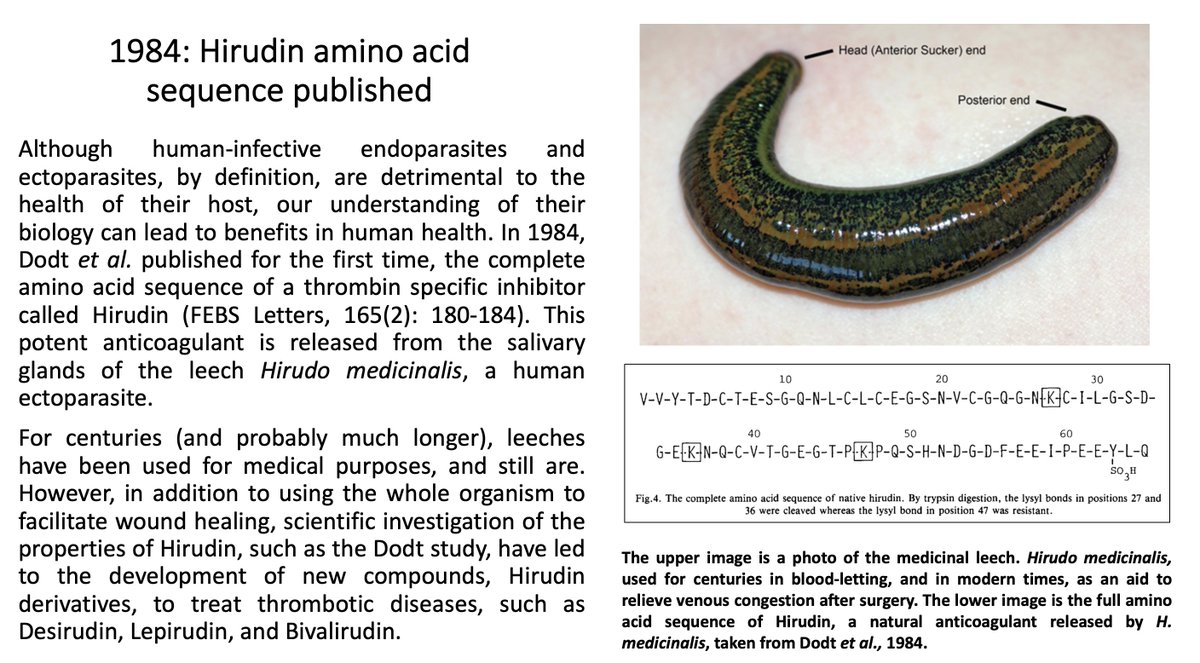
- Image references: thepmfajournal.com/features/post/…; sciencedirect.com/science/articl…
- References: https://t.co/mHSIZVM7yf; frontiersin.org/articles/10.33…; pubmed.ncbi.nlm.nih.gov/21932952/; ncbi.nlm.nih.gov/pmc/articles/P…; pubmed.ncbi.nlm.nih.gov/16614733/
- References: https://t.co/mHSIZVM7yf; frontiersin.org/articles/10.33…; pubmed.ncbi.nlm.nih.gov/21932952/; ncbi.nlm.nih.gov/pmc/articles/P…; pubmed.ncbi.nlm.nih.gov/16614733/
𝟭𝟵𝟴𝟱: In 1985, there was still no treatment for HIV/AIDS, and opportunistic parasitic infections among immunocompromised patients were increasing. Among them, the 1st case of the microsporidian, Enterocytozoon bieneusi, in a human, causing severe & chronic diarrhoea. 
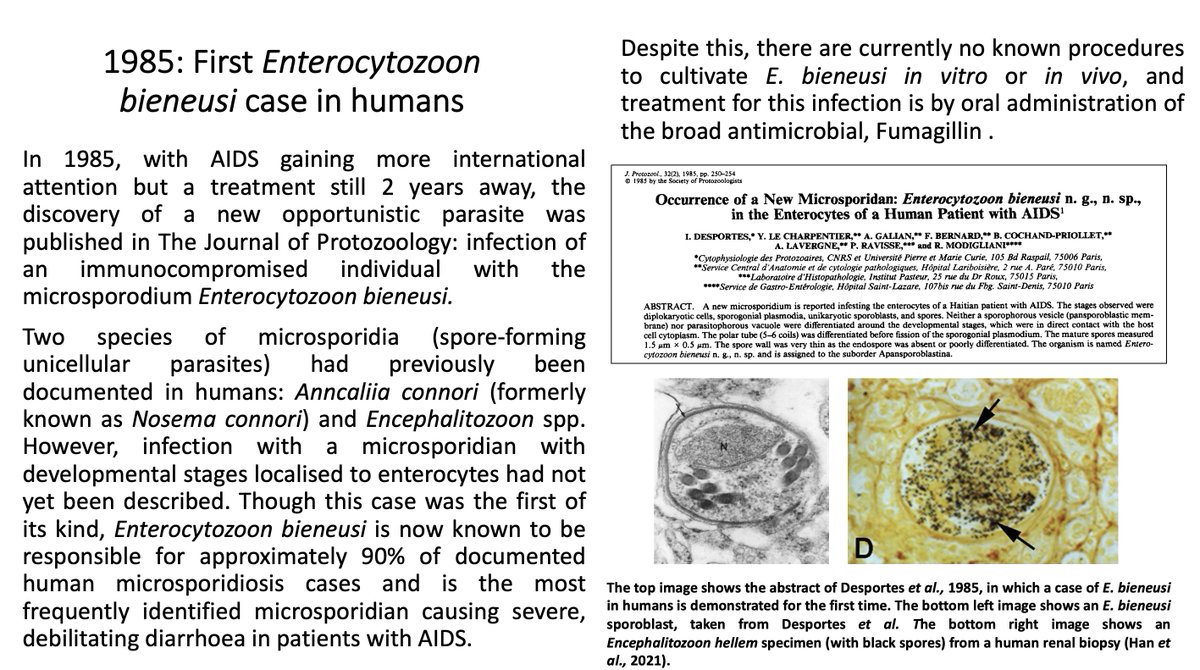
- Image references: pubmed.ncbi.nlm.nih.gov/4009510/; journals.asm.org/doi/10.1128/CM…
- References: nytimes.com/1987/03/21/us/…; https://t.co/ksHaFJmyfx; https://t.co/ATfpOBNfvH; ncbi.nlm.nih.gov/pmc/articles/P…
- References: nytimes.com/1987/03/21/us/…; https://t.co/ksHaFJmyfx; https://t.co/ATfpOBNfvH; ncbi.nlm.nih.gov/pmc/articles/P…
𝟭𝟵𝟴𝟲: Remarkably, our 1986 #Parasitology fact/breakthrough about #Cryptosporidium may be in the process of being debunked! 36 yrs ago, Current & Reese described Type I & Type II meronts, but current research throws Type II meronts into question! biorxiv.org/content/10.110… 

- Image references: onlinelibrary.wiley.com/doi/10.1111/j.…
- References: https://t.co/FWVom9H3UF; gastrojournal.org/article/0016-5…
- References: https://t.co/FWVom9H3UF; gastrojournal.org/article/0016-5…
𝟭𝟵𝟴𝟳: October 2022 will mark 35 years since the beginning of the Mectizan Donation Program (@MectizanMDP), when Merck & Co. agreed to provide oral ivermectin (Mectizan) for free- as much as needed for as long as needed- to tackle human #onchocerciasis ("River Blindness"). 

- Image references: mectizan.org/history/; cehjournal.org/article/onchoc…
- References: https://t.co/OyvUZCIq3Q; sciencedirect.com/science/articl…; ncbi.nlm.nih.gov/pmc/articles/P…; pubmed.ncbi.nlm.nih.gov/22039801/
- References: https://t.co/OyvUZCIq3Q; sciencedirect.com/science/articl…; ncbi.nlm.nih.gov/pmc/articles/P…; pubmed.ncbi.nlm.nih.gov/22039801/
𝟭𝟵𝟴𝟴: Providing a testament to just how long human infections with soil-transmitted helminths (STHs) can last, the renowned parasitologist, Dr Paul C. Beaver, published a study in 1988 describing a volunteer with a #Necator americanus infection 18 yrs after inoculation! 

- Image references: nature.com/articles/nrdp2… ;cdc.gov/dpdx/hookworm/…
- References: ajtmh.org/view/journals/…; https://t.co/sHR0EGDm7q; scielo.br/j/rsbmt/a/JFZH…; journals.plos.org/plosntds/artic…
- References: ajtmh.org/view/journals/…; https://t.co/sHR0EGDm7q; scielo.br/j/rsbmt/a/JFZH…; journals.plos.org/plosntds/artic…
𝟭𝟵𝟴𝟵: In 1989, @AkhilVaidya1 released a paper that rocked the worlds of both #malaria & mitochondia research! With the publication of a 6 kb extrachromosomal, linear sequence of P. yoelii DNA, Vaidya et al. showed that mtDNA was not always circular, & if this was the mtDNA... 

... then what were the circular DNA fragments that were isolated from apicomplexan parasites? What was this 3rd genetic element inside #Plasmodium cells that was not nuclear or mt? (spoiler: the 35 kb extrachromosomal DNA was from the apicoplast (not characterised until 1997!)).
- Image references: sciencedirect.com/science/articl…
- References: https://t.co/raMF3DEsZi; nature.com/scitable/topic…; annualreviews.org/doi/pdf/10.114…; sciencedirect.com/science/articl…; onlinelibrary.wiley.com/doi/10.1111/j.…; science.org/doi/10.1126/sc…
- References: https://t.co/raMF3DEsZi; nature.com/scitable/topic…; annualreviews.org/doi/pdf/10.114…; sciencedirect.com/science/articl…; onlinelibrary.wiley.com/doi/10.1111/j.…; science.org/doi/10.1126/sc…
𝟭𝟵𝟵𝟬: In 1990, a Czech parasitologist named Jaroslav Flegr was examining some diagnostic tests for #Toxoplasma gondii when his own test came up positive. This result profoundly effected Flegr who began questioning his own recent behaviour. Was it linked to the Toxoplasma? 

Following this, Flegr published dozens of studies examining the link between T. gondii & behavioural changes in humans!
- Image references: nationalgeographic.com/culture/articl…; theatlantic.com/magazine/archi…; discovermagazine.com/health/the-myt…; theconversation.com/is-the-brain-p…; link.springer.com/article/10.100…
- Image references: nationalgeographic.com/culture/articl…; theatlantic.com/magazine/archi…; discovermagazine.com/health/the-myt…; theconversation.com/is-the-brain-p…; link.springer.com/article/10.100…
- References: nationalgeographic.com/culture/articl…; pubmed.ncbi.nlm.nih.gov/7469564/; pubmed.ncbi.nlm.nih.gov/543216/; pubmed.ncbi.nlm.nih.gov/6660954/; cambridge.org/core/journals/…; bmcinfectdis.biomedcentral.com/articles/10.11…; journals.plos.org/plosone/articl…; theatlantic.com/magazine/archi…, discovermagazine.com/health/the-myt…; theconversation.com/is-the-brain-p… -
𝟭𝟵𝟵𝟭: Half way through our 60 day countdown today! And what a fact we have! In 1991, Viney, Ashford, & Barnish publish a paper naming a new #Strongyloides species: Strongyloides fuelleborni kellyi; the causative agent of "Swollen Belly Syndrome" in Papua New Guinea. #NTD 

Questions still remain today about whether #Strongyloides fuelleborni kellyi is a distinct species, or whether it is in fact another zoonotic species (suggested to be Strongyloides papillosus). More research is certainly needed. #NTD #Parasitology
- Image references: ajtmh.org/view/journals/…
- References: link.springer.com/article/10.100…; ncbi.nlm.nih.gov/books/NBK19795…; https://t.co/xESeG9SgMj; reader.elsevier.com/reader/sd/pii/…; reader.elsevier.com/reader/sd/pii/…; journals.plos.org/plosntds/artic…
- References: link.springer.com/article/10.100…; ncbi.nlm.nih.gov/books/NBK19795…; https://t.co/xESeG9SgMj; reader.elsevier.com/reader/sd/pii/…; reader.elsevier.com/reader/sd/pii/…; journals.plos.org/plosntds/artic…
𝟭𝟵𝟵𝟮: In 1992, Dr Edoardo Pozio and colleagues at the Istituto Superiore di Sanità in Italy published a revision of the #Trichinella genus of parasites: splitting the genus into 5 species with three additional genotypes. Dr Pozio remains a renowned Trichinella expert. 

- Image references: cdc.gov/parasites/tric…; sciencedirect.com/science/articl…
- References: https://t.co/PuGH1EPlYd; parasitesandvectors.biomedcentral.com/articles/10.11…; jstor.org/stable/3283540; jstor.org/stable/3283538; nature.com/articles/32160; sciencedirect.com/science/articl…; sciencedirect.com/science/articl…
- References: https://t.co/PuGH1EPlYd; parasitesandvectors.biomedcentral.com/articles/10.11…; jstor.org/stable/3283540; jstor.org/stable/3283538; nature.com/articles/32160; sciencedirect.com/science/articl…; sciencedirect.com/science/articl…
𝟭𝟵𝟵𝟯: In 1993, Ynés Ortega & colleagues published an article in the @NEJM describing a new protozoan pathogen of humans. Ortega identified it as a #Cyclospora parasite & in 1994 it would be named C. cayetanensis after her alma mater, the Universidad Peruana Cayetano Heredia. 
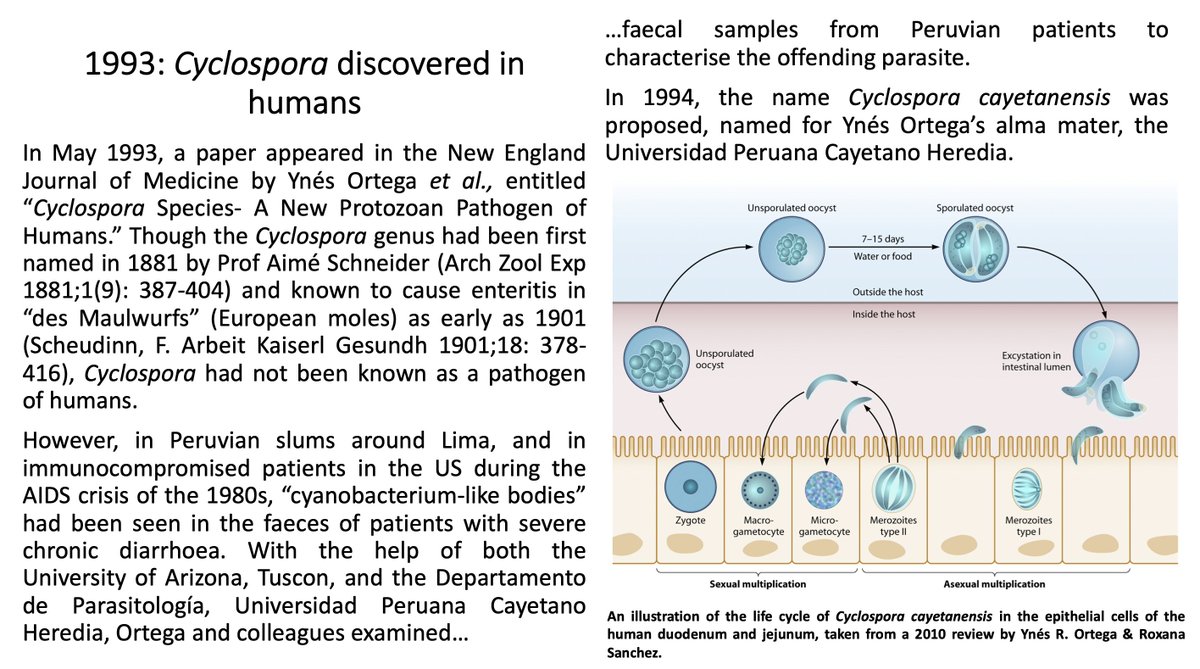
- Image references: ncbi.nlm.nih.gov/pmc/articles/P…
- References: nejm.org/doi/pdf/10.105…; https://t.co/eNuR0aS9If
- References: nejm.org/doi/pdf/10.105…; https://t.co/eNuR0aS9If
𝟭𝟵𝟵𝟰: In 1994, in the Veterinary Parasitology journal, McTier et al. demonstrated the efficacy of melarsomine dihydrochloride in treating canine #heartworm. The drug had far fewer side-effects compared to thiacetarsamide sodium, & is still used today alongside "Moxi-Doxy". 

"Moxi-Doxy" = macrocyclic lactone (often Moxidectin) + doxycycline treatment.
- Image references: cdc.gov/parasites/diro…
- References: sciencedirect.com/science/articl…; …-wiley-com.ezaccess.libraries.psu.edu/doi/epdf/10.11…; todaysveterinarypractice.com/ahs-heartworm-…; frontiersin.org/articles/10.33…
- Image references: cdc.gov/parasites/diro…
- References: sciencedirect.com/science/articl…; …-wiley-com.ezaccess.libraries.psu.edu/doi/epdf/10.11…; todaysveterinarypractice.com/ahs-heartworm-…; frontiersin.org/articles/10.33…
𝟭𝟵𝟵𝟱: In a major breakthrough for #malaria research, June 1995 would see the publication of van Dijk, Waters, & Janse in @ScienceMagazine: the 1st paper showing stable transfection of genetic material (drug-selectable plasmid DNA) into blood-stage #parasites of P. berghei! 

- Image references: science.org/doi/10.1126/sc…; academic.oup.com/milmed/article…
- References: ncbi.nlm.nih.gov/pmc/articles/P…; https://t.co/4SsKCeGhDV; jstor.org/stable/38760; ncbi.nlm.nih.gov/pmc/articles/P…
- References: ncbi.nlm.nih.gov/pmc/articles/P…; https://t.co/4SsKCeGhDV; jstor.org/stable/38760; ncbi.nlm.nih.gov/pmc/articles/P…
𝟭𝟵𝟵𝟲: At the beginning of 1996, with HAART therapy for HIV/AIDS just being rolled out, a new #microsporidian infection of humans was discovered in an immunocompromised patient. The Pleistophora-like pathogen would be named #Trachipleistophora hominis, often invading muscle. 

- Image reference: journals.asm.org/doi/epdf/10.11…
- References: scielosp.org/pdf/aiss/2011.…; pubmed.ncbi.nlm.nih.gov/8587798/; https://t.co/rcZh8SwQok; pubmed.ncbi.nlm.nih.gov/9627987/
- References: scielosp.org/pdf/aiss/2011.…; pubmed.ncbi.nlm.nih.gov/8587798/; https://t.co/rcZh8SwQok; pubmed.ncbi.nlm.nih.gov/9627987/
𝟭𝟵𝟵𝟳: In 1997, an important article in @TheLancet was published which informed the world about an unforseen serious reaction to ivermectin (encephalopathy) in patients who were treated for #onchocerciasis who also had a #loaloa infection of high microfilarial load. #NTDs 

- Image references: thelancet.com/journals/lance…; journals.plos.org/plosntds/artic…
- References: https://t.co/wdZjS3tVlH; pubmed.ncbi.nlm.nih.gov/1858969/; https://t.co/rHkO43gBfX
- References: https://t.co/wdZjS3tVlH; pubmed.ncbi.nlm.nih.gov/1858969/; https://t.co/rHkO43gBfX
𝟭𝟵𝟵𝟴: In 1998, Fire et al. published a study in C. elegans describing the use of specific double-stranded RNAs to silence genes of interest. This would begin the field of RNA interference (RNAi) which would go on to be used to great effect in #Trypanosoma research! #parasites 
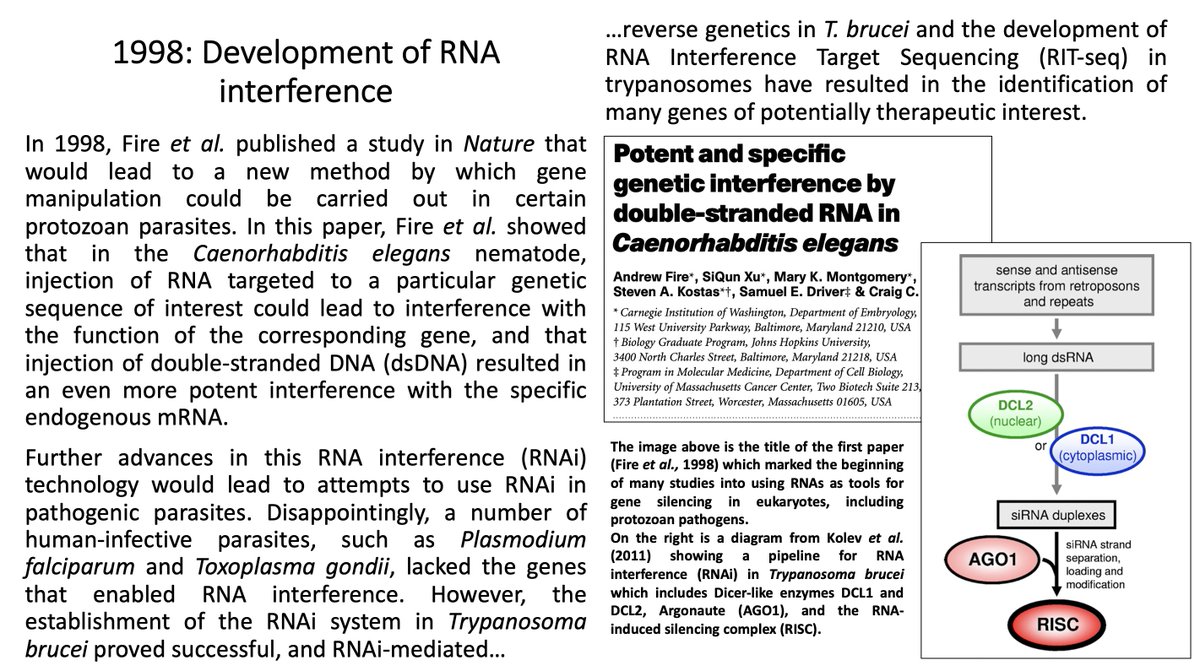
- Image references: nature.com/articles/35888; ncbi.nlm.nih.gov/pmc/articles/P…
- References: https://t.co/Vkvf6zk2Md; nature.com/articles/35078…; ncbi.nlm.nih.gov/pmc/articles/P…; https://t.co/8SDPkpitx4
- References: https://t.co/Vkvf6zk2Md; nature.com/articles/35078…; ncbi.nlm.nih.gov/pmc/articles/P…; https://t.co/8SDPkpitx4
𝟭𝟵𝟵𝟵: In 1999, Kiyoshi Nakauchi of the Ken-sei Meat Inspection Office in Ibaraki, Japan, carried out the largest investigation of host species for a little understood human parasite, #Balantidium coli. B. coli is the only ciliated protozoan known to cause disease in humans! 

- Image reference: cdc.gov/dpdx/balantidi…
- References: jstage.jst.go.jp/article/jvms/6…; ncbi.nlm.nih.gov/pmc/articles/P…; ajtmh.org/view/journals/…
- References: jstage.jst.go.jp/article/jvms/6…; ncbi.nlm.nih.gov/pmc/articles/P…; ajtmh.org/view/journals/…
𝟮𝟬𝟬𝟬: In June 2000, a new molecular technique was deascribed by Tsugunori Notomi & colleagues in @NAR_Open: loop-mediated isothermal amplification (LAMP) of DNA. Further studies with LAMP have shown its potential as a method for molecular diagnosis of #parasitic diseases. 

- Image reference: tandfonline.com/doi/full/10.10…
- References: ncbi.nlm.nih.gov/pmc/articles/P…; https://t.co/CL1LkRNnwi; pnas.org/content/pnas/e…; nature.com/articles/s4159…; journals.plos.org/plosone/articl…; nature.com/articles/s4159…
- References: ncbi.nlm.nih.gov/pmc/articles/P…; https://t.co/CL1LkRNnwi; pnas.org/content/pnas/e…; nature.com/articles/s4159…; journals.plos.org/plosone/articl…; nature.com/articles/s4159…
𝟮𝟬𝟬𝟭: #Parasitology fact 40/60 today! In 2001, a study by Achim Hoerauf et al. appeared in @TheLancet which demonstrated the effectiveness of targeting Wolbachia bacteria inside its worm host when trying to kill the worm itself! This led to new antiparasitic treatment options 

- Image reference: ncbi.nlm.nih.gov/pmc/articles/P…
- References: thelancet.com/journals/lance…; pubmed.ncbi.nlm.nih.gov/1228988/; sciencedirect.com/science/articl…; https://t.co/pIkWNN5P4t; proquest.com/docview/206996…; lstmed.ac.uk/news-events/ne…
- References: thelancet.com/journals/lance…; pubmed.ncbi.nlm.nih.gov/1228988/; sciencedirect.com/science/articl…; https://t.co/pIkWNN5P4t; proquest.com/docview/206996…; lstmed.ac.uk/news-events/ne…
𝟮𝟬𝟬𝟮: In 2002, the first full genome of a human #malaria-causing parasite was released in @Nature; the genome of #Plasmodium falciparum, the species responsible for the most severe cases of malaria in humans. Since then, 7000+ P. falciparum isolates have been sequenced! 

- Image reference: pubmed.ncbi.nlm.nih.gov/33824913/
- References: nature.com/articles/natur…; nature.com/articles/35106…; science.org/doi/10.1126/sc…; https://t.co/S9eVFVQIEx
- References: nature.com/articles/natur…; nature.com/articles/35106…; science.org/doi/10.1126/sc…; https://t.co/S9eVFVQIEx
𝟮𝟬𝟬𝟯: In Feb '03, clinician & parasitologist, Dr Carlo Urbani, at the French Hospital of Hanoi, Vietnam, alerted the WHO in Geneva of an outbreak of pneumonia of unknown cause at the hospital. His swift actions prevented the spread of the unknown infection: now known as SARS. 

- Image references: zenodo.org/record/4395844…; who.int/news/item/28-0…; ncbi.nlm.nih.gov/pmc/articles/P…
- References: pubmed.ncbi.nlm.nih.gov/9304009/; zenodo.org/record/4395844…; thelancet.com/pdfs/journals/…
- References: pubmed.ncbi.nlm.nih.gov/9304009/; zenodo.org/record/4395844…; thelancet.com/pdfs/journals/…
𝟮𝟬𝟬𝟰: In 2004, Ana Flisser & colleagues published a study that demonstrated the effectiveness of 2 recombinant #Taenia solium oncosphere antigens, TSOL18 and TSOL45-1A, as vaccine candidates for the prevention of zoonotic cysticercosis from pigs! Field trials are ongoing! 

- Image references: ncbi.nlm.nih.gov/pmc/articles/P…; vethelplineindia.co.in/wp-content/upl…
- References: https://t.co/tRkSAI6JHG; …ringer-com.ezaccess.libraries.psu.edu/content/pdf/10…; frontiersin.org/articles/10.33…; journals.plos.org/plosntds/artic…
- References: https://t.co/tRkSAI6JHG; …ringer-com.ezaccess.libraries.psu.edu/content/pdf/10…; frontiersin.org/articles/10.33…; journals.plos.org/plosntds/artic…
𝟮𝟬𝟬𝟱: In 2005, in a collaboration between @DNDi and Hoechst AG (now Sanofi), a screening of compounds for trypanocidal activity discovered the efficacy of Fexinidazole against #Trypanosoma brucei (gambiense & rhodesiense) in vitro. Today, it is an oral trypanocidal treatment! 

- Image references: link.springer.com/article/10.100…;
- References: https://t.co/jJRjUprnDB; dndi.org/press-releases…
https://twitter.com/ntdworld/status/1222209685836746753;
- References: https://t.co/jJRjUprnDB; dndi.org/press-releases…
𝟮𝟬𝟬𝟲: In '06, the first @veupathdb version, the Apicomplexa Database (ApiDB) was released, incorporating component sites PlasmoDB, ToxoDB, & CryptoDB with genome data from apicomplexan species without dedicated databases. 16 yrs on, @veupathdb is still an invaluable resource! 

- Image references: ncbi.nlm.nih.gov/pmc/articles/P…; veupathdb.org/veupathdb/app
- References: https://t.co/I3g16c1SKH; https://t.co/zzOavCNvzG; academic.oup.com/nar/advance-ar…
- References: https://t.co/I3g16c1SKH; https://t.co/zzOavCNvzG; academic.oup.com/nar/advance-ar…
𝟮𝟬𝟬𝟳: In 2007, two separate studies were published by Morrison et al. and Cooper et al. respectively that raised the same (still unanswered!) question about reproduction in #Giardia duodenalis parasites (a.k.a G. lamblia or G. intestinalis): can Giardia reproduce by meiosis? 

- Image references: pubmed.ncbi.nlm.nih.gov/17901334/; core.ac.uk/download/pdf/8…
- References: https://t.co/UbLBmU5MCv; https://t.co/qCN2Tl20nv; bio.umass.edu/micro/klingbei…; nature.com/articles/s4159…
- References: https://t.co/UbLBmU5MCv; https://t.co/qCN2Tl20nv; bio.umass.edu/micro/klingbei…; nature.com/articles/s4159…
𝟮𝟬𝟬𝟴: In '08, Dr Armand Kuris & colleagues published a study in @Nature examining the ecosystem energetic implications of parasite biomass in 3 estuaries, showing that in these systems, parasites made up a considerable proportion of biomass; much more than perviously thought. 
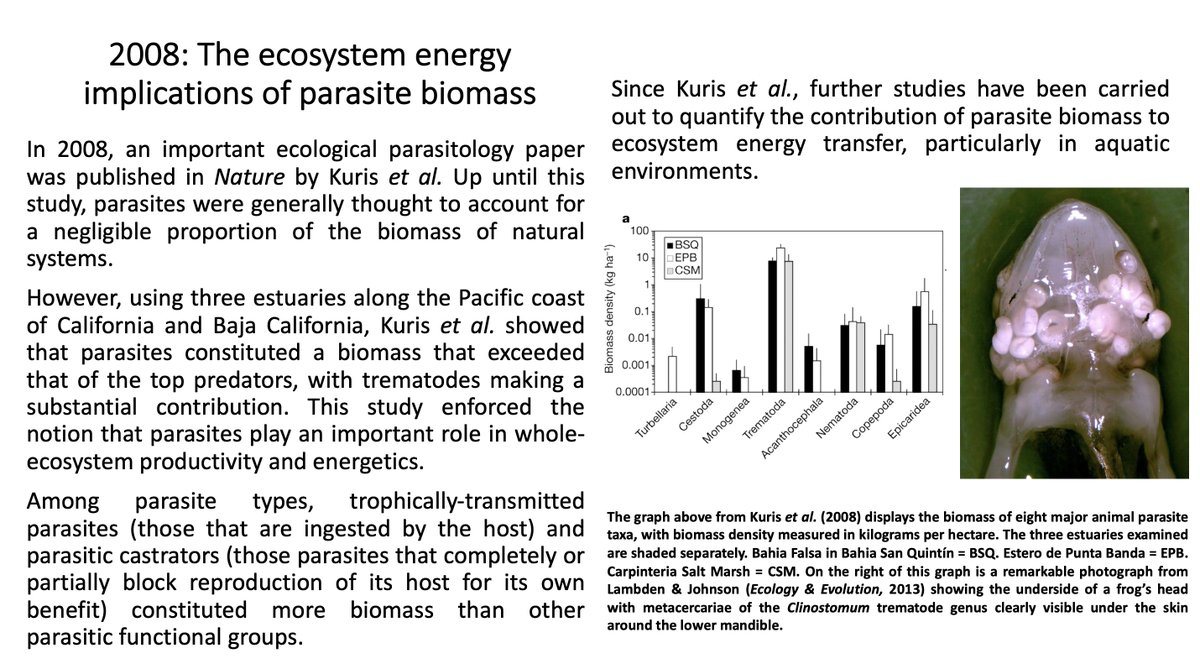
- Image references: nature.com/articles/natur…; ncbi.nlm.nih.gov/pmc/articles/P…
- References: sciencedirect.com/science/articl…; https://t.co/DXJJKPV4CM; ncbi.nlm.nih.gov/pmc/articles/P…
- References: sciencedirect.com/science/articl…; https://t.co/DXJJKPV4CM; ncbi.nlm.nih.gov/pmc/articles/P…
𝟮𝟬𝟬𝟵: In 2009, Dr Dennis Tappe & Dr Dietrich Büttner of @BNITM_de published updated guidelines for the diagnosis of the rare NTD, human visceral #pentastomiasis. Pentastomes are also called "tongue-worms" & have no treatment other than surgical excision in human patients! 

- Image references: journals.plos.org/plosntds/artic…; journals.plos.org/plosntds/artic…
- References: https://t.co/Ha7kQX3Tzi; https://t.co/ip1uaduRhb
- References: https://t.co/Ha7kQX3Tzi; https://t.co/ip1uaduRhb
𝟮𝟬𝟭𝟬: In 2010, Sutherland et al. published a study in The Journal of Infectious Diseases that updated the taxonomy of the #Plasmodium genus. Based on multilocus sequence analysis, P. ovale was divided into 2 sympatric species: P. ovale curtisi and P. ovale wallikeri. #malaria 

- Image reference: pubmed.ncbi.nlm.nih.gov/20380562/
- References: https://t.co/TOC7FB9rz7; ajtmh.org/view/journals/…; nature.com/articles/s4159…
- References: https://t.co/TOC7FB9rz7; ajtmh.org/view/journals/…; nature.com/articles/s4159…
𝟮𝟬𝟭𝟭: In 2011, 5 outbreaks of the equine disease "dourine" occurred in Southern Italy, the first official cases since 1996. "Dourine" is the colloquial term for an illness caused by an infection of equines with #Trypanosoma equiperdum. A nationwide surveillance was enacted. 

- Image reference: gavinpublishers.com/assets/article…
- References: izs.it/vet_italiana/2…; izs.it/IZS/Engine/RAS…; oie.int/app/uploads/20…; parasitesandvectors.biomedcentral.com/articles/10.11…; pubmed.ncbi.nlm.nih.gov/15923142/
- References: izs.it/vet_italiana/2…; izs.it/IZS/Engine/RAS…; oie.int/app/uploads/20…; parasitesandvectors.biomedcentral.com/articles/10.11…; pubmed.ncbi.nlm.nih.gov/15923142/
We have a few facts to catch up on after #BSP60York! 𝟮𝟬𝟭𝟮: In 2012, a study was published in @ScienceMagazine that would increase the molecular tools available to parasitologists (& other biologists!): the mechanism of the programmable CRISPR/Cas systems! #parasitology 

- Image reference: science.org/doi/full/10.11…
- References: https://t.co/sB3jUUTLN6; nature.com/articles/s4159…; academic.oup.com/bfg/article/18…; journals.asm.org/doi/10.1128/mS…; journals.asm.org/doi/10.1128/mS…; pubmed.ncbi.nlm.nih.gov/33337558/; veterinaryresearch.biomedcentral.com/articles/10.11…
- References: https://t.co/sB3jUUTLN6; nature.com/articles/s4159…; academic.oup.com/bfg/article/18…; journals.asm.org/doi/10.1128/mS…; journals.asm.org/doi/10.1128/mS…; pubmed.ncbi.nlm.nih.gov/33337558/; veterinaryresearch.biomedcentral.com/articles/10.11…
𝟮𝟬𝟭𝟯: In 2013 came the publication of Laing et al., the first publication of the genome of a strongylid nematode #parasite, published along with comprehensive transcriptomic data from 6 different life stages & one distinct infection stage (the female adult in the gut). 

- Image references: actwessex.co.uk/post/haemonchu…; ncbi.nlm.nih.gov/pmc/articles/P…
- References: https://t.co/BNVnhMFH20; sciencedirect.com/science/articl…; nature.com/articles/ng.34…; nature.com/articles/ng.28…; nature.com/articles/ng.32…
- References: https://t.co/BNVnhMFH20; sciencedirect.com/science/articl…; nature.com/articles/ng.34…; nature.com/articles/ng.28…; nature.com/articles/ng.32…
𝟮𝟬𝟭𝟰: In 2014, the secret behind gametocyte commitment in #malaria/#Plasmodium parasites (and therefore a target for transmission-blocking interventions) was identified in 2 back-to-back publications by Abhinav Sinha et al. & Björn Kafsack et al.: expression of AP2-G! 

- Image references: ncbi.nlm.nih.gov/pmc/articles/P…; ncbi.nlm.nih.gov/pmc/articles/P…
- References: https://t.co/ibNA34hr4b; https://t.co/2qOfkYNDD8
- References: https://t.co/ibNA34hr4b; https://t.co/2qOfkYNDD8
Almost to the exact 60th Anniversary of the BSP in April!
𝟮𝟬𝟭𝟱: In 2015, two discoveries were made about the common bed bug, a human #ectoparasite. 1st: the chemical components of the #Cimex lectularius aggregation pheromone were identified. & they can transmit T. cruzi!
𝟮𝟬𝟭𝟱: In 2015, two discoveries were made about the common bed bug, a human #ectoparasite. 1st: the chemical components of the #Cimex lectularius aggregation pheromone were identified. & they can transmit T. cruzi!

- Image references: pubmed.ncbi.nlm.nih.gov/22235873/; onlinelibrary.wiley.com/doi/abs/10.100…; ncbi.nlm.nih.gov/pmc/articles/P…
- References: https://t.co/rF4y7TLCub; https://t.co/NBU1oz6pmw; https://t.co/zXb96hSnbZ
- References: https://t.co/rF4y7TLCub; https://t.co/NBU1oz6pmw; https://t.co/zXb96hSnbZ
𝟮𝟬𝟭𝟲: In 2016, a study by the @MacLeod_Group at the University of Glasgow released a significant finding in the study of #Trypanosoma: that even in the absence of parasites within blood, and in asymptomatic hosts, African trypanosomes could still be present- in the host skin! 

- Image reference: elifesciences.org/articles/17716
- References: https://t.co/PcazoGZAQF; parasite-journal.org/articles/paras…
- References: https://t.co/PcazoGZAQF; parasite-journal.org/articles/paras…
𝟮𝟬𝟭𝟳: In 2017, the @WHO formally added "Scabies and other #Ectoparasites" to the list of NTDs. "Scabies" is the common name given to an infection with #Sarcoptes scabei mites, the females of which burrow under the skin to lay eggs. Itching & secondary infections often occur. 
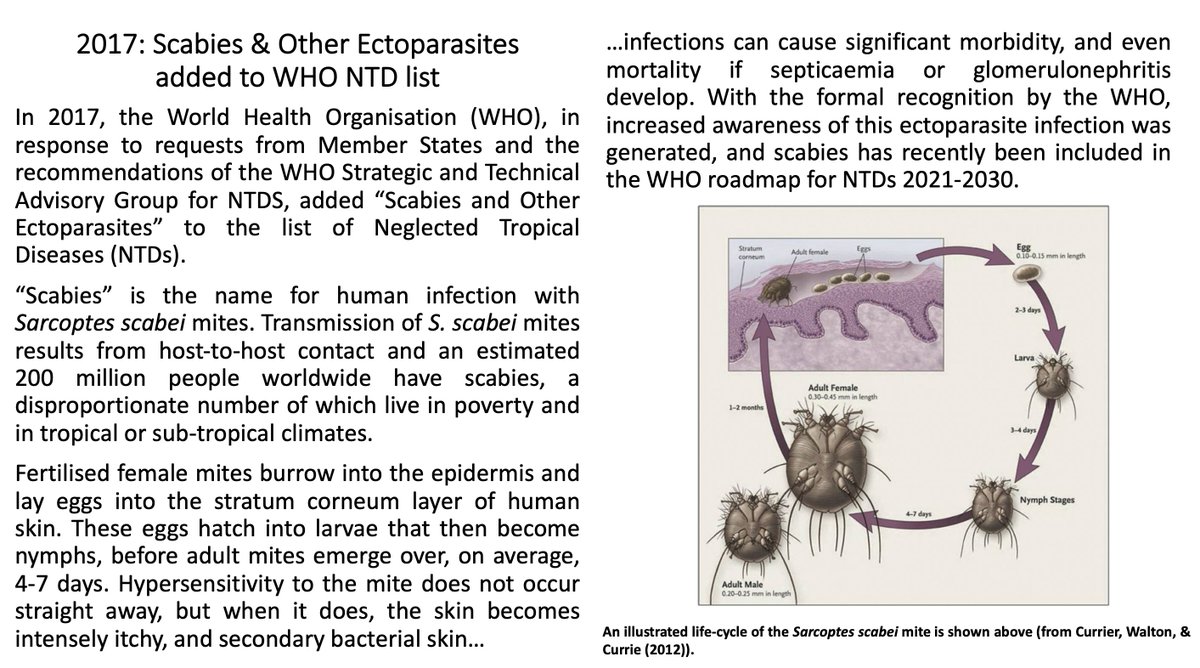
- Image reference: nyaspubs.onlinelibrary.wiley.com/doi/epdf/10.11…
- References: who.int/news-room/fact…; tropmedhealth.biomedcentral.com/articles/10.11…; ncbi.nlm.nih.gov/pmc/articles/P…
- References: who.int/news-room/fact…; tropmedhealth.biomedcentral.com/articles/10.11…; ncbi.nlm.nih.gov/pmc/articles/P…
1 more #parasite fact/breakthrough today!
𝟮𝟬𝟭𝟴: In 2018, a young girl in Angola became the first person in that country to be diagnosed with "Guinea worm disease", i.e. an infection with a Dracunculus medinensis nematode. The mystery remains as to how transmission occurred!
𝟮𝟬𝟭𝟴: In 2018, a young girl in Angola became the first person in that country to be diagnosed with "Guinea worm disease", i.e. an infection with a Dracunculus medinensis nematode. The mystery remains as to how transmission occurred!

- Image reference: britannica.com/animal/guinea-…
- References: thelancet.com/journals/lance…; thelancet.com/journals/lanin…; journals.plos.org/plosntds/artic…
- References: thelancet.com/journals/lance…; thelancet.com/journals/lanin…; journals.plos.org/plosntds/artic…
𝟮𝟬𝟭𝟵: In 2019, parasitologists got a stark reminder that there is still much we don't know about #Parasitology, and new human-infectious #parasites can emerge, even today. In @EIDjournal, Maruyama et al. studied a case of a #Crithidia-like fatal parasitic infection in a man. 

- Image reference: ncbi.nlm.nih.gov/pmc/articles/P…
- Reference: https://t.co/kIEAlSJhby
- Reference: https://t.co/kIEAlSJhby
𝟮𝟬𝟮𝟬: In 2020, another new species of human-infective #parasite was discovered! This time the culprit for gastrointestinal issues in riparian people living along the Mekong River in Cambodia was the product of infection with a fluke, now named #Echinostoma mekongi n. sp.! 

- Image reference: ncbi.nlm.nih.gov/pmc/articles/P…
- References: https://t.co/tRxbYBcv5G; ncbi.nlm.nih.gov/pmc/articles/P…
- References: https://t.co/tRxbYBcv5G; ncbi.nlm.nih.gov/pmc/articles/P…
𝟮𝟬𝟮𝟭: In 2021, the @WHO approved the use of a #malaria vaccine, RTS,S/AS01 (commercially known as "Mosquirix") for the prevention of #Plasmodium falciparum infection in humans. Children between 6 weeks & 17 months of age are prioritised for life-saving immunisation. 

- Image references: dovepress.com/getfile.php?fi…; ncbi.nlm.nih.gov/pmc/articles/P…
- References: who.int/news/item/06-1…; https://t.co/bTPmmimzey; tandfonline.com/doi/pdf/10.416…; https://t.co/hBWvTmZQYT
- References: who.int/news/item/06-1…; https://t.co/bTPmmimzey; tandfonline.com/doi/pdf/10.416…; https://t.co/hBWvTmZQYT
@threadreaderapp unroll
• • •
Missing some Tweet in this thread? You can try to
force a refresh













